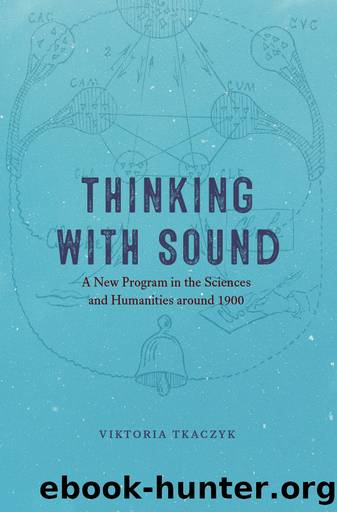Thinking with Sound by Viktoria Tkaczyk

Author:Viktoria Tkaczyk [Tkaczyk, Viktoria]
Language: eng
Format: epub
Tags: MUS000000 MUSIC / General, MUS020000 MUSIC / History & Criticism, SCI001000 SCIENCE / Acoustics & Sound, HIS010000 HISTORY / Europe / General
Publisher: University of Chicago Press
Published: 2023-01-13T00:00:00+00:00
The Politics of Testing Musicality
In his writings on absolute tone consciousness, Abraham suggested several new methods of applying his findings to the training of audition.105 Again, the education of the larynx and auditory-motor associations more generally was an important objective. Advising on teaching singing to youngsters, for instance, Abraham warned that they should not be confronted with too many voice models at once, because the mother, father, and siblings all work from âdifferent larynxesâ and therefore risk confusing the childâs tone judgment.106 Instead, Abraham proposed to train the associative capacities by confronting children daily with the sound of tuning forks or whistles and inviting them to develop their own acoustic, visual, and motor associations with the soundsâif need be, by rewarding their arduous and solitary âassociative workâ with pieces of chocolate.107
Abrahamâs testing and training methods never gained a particularly high profile. They were, though, famously taken up by Georg Schünemann, a music educator at the Berlin Academy of Music. In 1921, Schünemann established his aptitude testâa âtest for the talented,â Begabtenprüfungâat a time when young musicians from the age of thirteen were being sought for the Academyâs orchestra classes, which were expanding for military reasons.108 Schünemannâs test sheets covered intelligence, perceptiveness, grasp of tones and harmonies, grasp of rhythm, and melody, and were complemented, as was Abrahamâs survey, by a set of medical examinations to evaluate the test subjectsâ physical aptitude, including motor perception.109
In the subsequent years, Schünemann refined his entrance examinations, considering them essential to a new musical education founded, again influenced by Abraham, less on the belief in innate talents and the wunderkind ideal than on the identification of musical âtotal personalities.â110 I will return in chapter 6 to Schünemann, some of whose tests and training methods continued to be applied at the radio laboratory he directed at the Academy of Music from 1928 to 1935. For the moment, it is important to note that Abrahamâs view of musicality as an ability based on unconscious associations between sensory centers in the brain, the larynx, and the whole body may, through the intercession of Schünemann, have influenced the testing and training of thousands of musicians who applied to and studied at German conservatories in the 1920s.
Another line of influence leads from Abrahamâs broad-based notion of musical talent to Carl Emil Seashoreâs âMeasures of Musical Talent,â which were once applied at numerous educational institutions in the United States and Europe.111 After earning his doctorate at Yale in 1895, Seashore traveled through Europe and seems to have been in contact with Stumpfâs Institute of Psychology in Berlin, where Abraham was working.112 On this occasion, Seashore may have learned about Abrahamâs strong conviction that musicality is a matter of education. Back in the United States, Seashore soon obtained a professorship at the University of Iowa and began to develop, quite in line with Abrahamâs phonographic tests of absolute tone consciousness, a series of musicality tests with âpure tonesâ produced by tuning fork sounds augmented by a vacuum tube resonator.113
Unlike Abraham, who considered
Download
This site does not store any files on its server. We only index and link to content provided by other sites. Please contact the content providers to delete copyright contents if any and email us, we'll remove relevant links or contents immediately.
The Complete Stick Figure Physics Tutorials by Allen Sarah(7310)
Secrets of Antigravity Propulsion: Tesla, UFOs, and Classified Aerospace Technology by Ph.D. Paul A. Laviolette(5310)
Thing Explainer by Randall Munroe(3877)
The River of Consciousness by Oliver Sacks(3542)
The Order of Time by Carlo Rovelli(3145)
How To by Randall Munroe(3037)
A Brief History of Time by Stephen Hawking(2962)
I Live in the Future & Here's How It Works by Nick Bilton(2938)
The Great Unknown by Marcus du Sautoy(2648)
What If?: Serious Scientific Answers to Absurd Hypothetical Questions by Randall Munroe(2637)
Midnight in Chernobyl by Adam Higginbotham(2483)
Blockchain: Ultimate Step By Step Guide To Understanding Blockchain Technology, Bitcoin Creation, and the future of Money (Novice to Expert) by Keizer Söze(2450)
Networks: An Introduction by Newman Mark(2360)
The Meaning of it All by Richard Feynman(2300)
Easy Electronics by Charles Platt(2282)
The Tao of Physics by Fritjof Capra(2231)
Midnight in Chernobyl: The Untold Story of the World's Greatest Nuclear Disaster by Adam Higginbotham(2177)
When by Daniel H Pink(2084)
Introducing Relativity by Bruce Bassett(2080)
